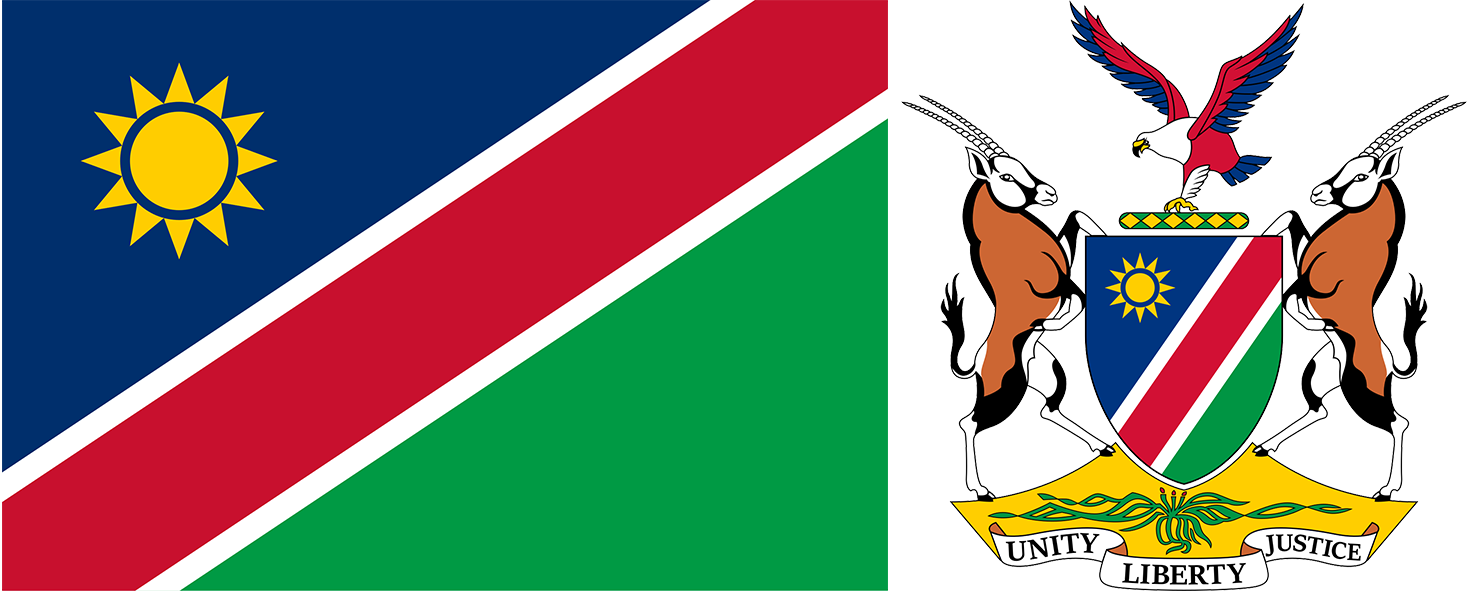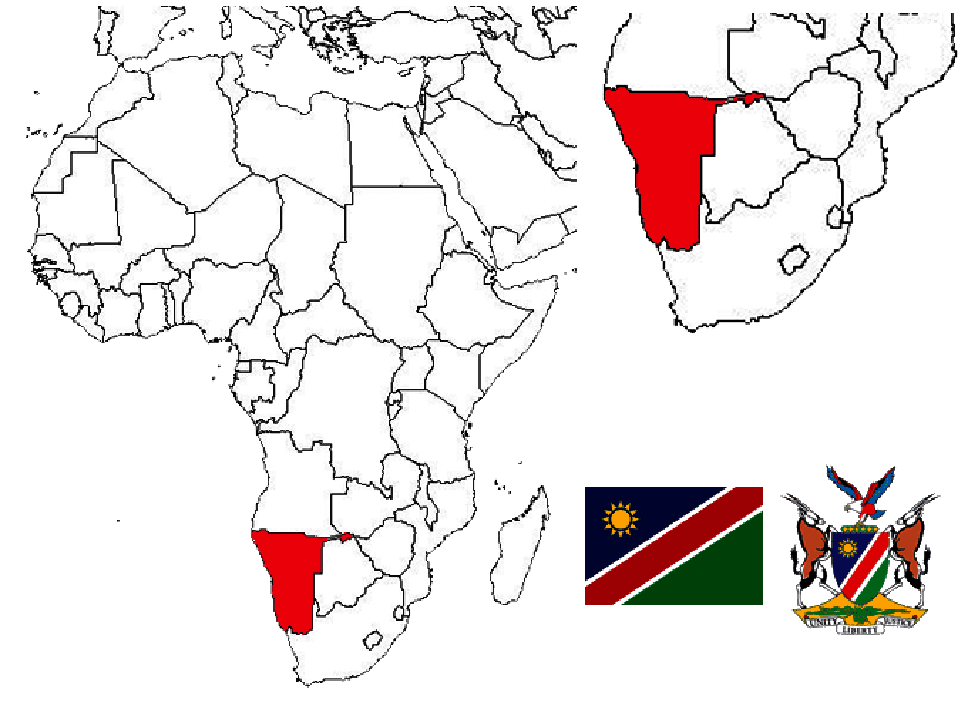FabulousFusionFood's Namibian recipes Home Page
 The flag of Namibia (left) and the Coat of Arms (right).
The flag of Namibia (left) and the Coat of Arms (right).
Welcome to the summary page for FabulousFusionFood's Namibian recipes, part of the African Continent. This page provides links to all the Namibian recipes presented on this site, with 22 recipes in total.
Namibia, officially: the Republic of Namibia is a coutry on the western seaboard of Southern Africa. Its capital and largest city is Windhoek (German: Windhuk) and the country gained independence from South Africa on March 21st 1990.
The traditional staples of Namibian cuisine are corn or millet porridge served with meat or fish stews. However, the German tradition is strong in Namibia (its having been a former German colony) and local dishes tend to be heavy on paste, meat and vegetables such as potatoes, cabbage, celery and rice. As might be expected from the admixture of German traditions hams and sausages also feature quite heavily in the diet. Shellfish dishes are traditionally served with corn-based breads. Like most of Southern Africa braais (Southern African barbecues) and potjikos (a hot stew of meat, Chicken or fish cooked over an open fire in a cast-iron, three-legged pot) are also a feature of the cuisine.
Namibia, officially the Republic of Namibia (Republiek van Namibië in Afrikaans; Republik Namibia in German; Republiki Namibiab dib in Khoekhoegowab), is a country in Southern Africa. Its western border is the Atlantic Ocean. It shares land borders with Angola and Zambia to the north, Botswana to the east and South Africa to the east and south. Although it does not border Zimbabwe, less than 200 metres (660 feet) of the Botswanan right bank of the Zambezi River separates the two countries. Its capital and largest city is Windhoek.
 The image above shows Namibia in (red) in relation to Africa (left) and
The image above shows Namibia in (red) in relation to Africa (left) and
Southern Africa (right).The driest country in sub-Saharan Africa, Namibia has been inhabited since pre-historic times by the Khoi, San, Damara and Nama people. Around the 14th century, immigrating Bantu peoples arrived as part of the Bantu expansion. Since then, the Bantu groups, the largest being the Ovambo, have dominated the population of the country; since the late 19th century, they have constituted a majority. With a population of 3,022,401 people today, Namibia is one of the most sparsely populated countries in the world.
In 1884, the German Empire established rule over most of the territory, forming a colony known as German South West Africa. Between 1904 and 1908, German troops waged a punitive campaign against the Herero and Nama which escalated into the first genocide of the 20th century. German rule ended during the First World War with a 1915 defeat by South African forces. In 1920, after the end of the war, the League of Nations mandated administration of the colony to South Africa. From 1948, with the National Party elected to power, this included South Africa applying apartheid to what was then known as South West Africa. In the later 20th century, uprisings and demands for political representation resulted in the United Nations assuming direct responsibility over the territory in 1966, but South Africa maintained de facto rule until 1973, when the UN recognized the South West Africa People's Organization (SWAPO) as the official representative of the Namibian people. Namibia gained independence from South Africa on 21 March 1990, following the South African Border War. However, Walvis Bay and the Penguin Islands remained under South African control until 1994.
Namibia is a stable parliamentary democracy. Agriculture, tourism and the mining industry – including mining for gem diamonds, uranium, gold, silver and base metals – form the basis of its economy, while the manufacturing sector is comparatively small. Despite significant GDP growth since its independence, poverty and inequality remain significant in the country. 40.9% of the population is affected by multidimensional poverty,[19] and more than 400,000 people continue to live in informal housing. Income disparity in the country is one of the world's highest with a Gini coefficient of 59.1 in 2015.
The name of the country is derived from the Namib desert, the oldest desert in the world. The word Namib itself is of Nama origin and means 'vast place'. The name was chosen by Mburumba Kerina, who originally proposed 'Republic of Namib'. Before Namibia became independent in 1990, its territory was known first as German South-West Africa (Deutsch-Südwestafrika), and then as South West Africa, reflecting its colonial occupation by Germans and South Africans, respectively.
For agriculturalists, the staple foods are maize, millet and sorghum; for pastoralists, dairy products. Beans and greens are eaten with millet in the north, but otherwise few vegetables are grown or consumed. Hunting and gathering, more important in the past, still provides a dietary supplement for some. Meat is highly desired and eaten. Important occasions are marked by the slaughter of cattle or goats, and the consumption of meat, home-brewed beer, purchased beverages, and other foods. In some cultures, leftover meat is sent home with the guests.
Namibia, officially: the Republic of Namibia is a coutry on the western seaboard of Southern Africa. Its capital and largest city is Windhoek (German: Windhuk) and the country gained independence from South Africa on March 21st 1990.
The traditional staples of Namibian cuisine are corn or millet porridge served with meat or fish stews. However, the German tradition is strong in Namibia (its having been a former German colony) and local dishes tend to be heavy on paste, meat and vegetables such as potatoes, cabbage, celery and rice. As might be expected from the admixture of German traditions hams and sausages also feature quite heavily in the diet. Shellfish dishes are traditionally served with corn-based breads. Like most of Southern Africa braais (Southern African barbecues) and potjikos (a hot stew of meat, Chicken or fish cooked over an open fire in a cast-iron, three-legged pot) are also a feature of the cuisine.
Namibia, officially the Republic of Namibia (Republiek van Namibië in Afrikaans; Republik Namibia in German; Republiki Namibiab dib in Khoekhoegowab), is a country in Southern Africa. Its western border is the Atlantic Ocean. It shares land borders with Angola and Zambia to the north, Botswana to the east and South Africa to the east and south. Although it does not border Zimbabwe, less than 200 metres (660 feet) of the Botswanan right bank of the Zambezi River separates the two countries. Its capital and largest city is Windhoek.
 The image above shows Namibia in (red) in relation to Africa (left) and
The image above shows Namibia in (red) in relation to Africa (left) andSouthern Africa (right).
In 1884, the German Empire established rule over most of the territory, forming a colony known as German South West Africa. Between 1904 and 1908, German troops waged a punitive campaign against the Herero and Nama which escalated into the first genocide of the 20th century. German rule ended during the First World War with a 1915 defeat by South African forces. In 1920, after the end of the war, the League of Nations mandated administration of the colony to South Africa. From 1948, with the National Party elected to power, this included South Africa applying apartheid to what was then known as South West Africa. In the later 20th century, uprisings and demands for political representation resulted in the United Nations assuming direct responsibility over the territory in 1966, but South Africa maintained de facto rule until 1973, when the UN recognized the South West Africa People's Organization (SWAPO) as the official representative of the Namibian people. Namibia gained independence from South Africa on 21 March 1990, following the South African Border War. However, Walvis Bay and the Penguin Islands remained under South African control until 1994.
Namibia is a stable parliamentary democracy. Agriculture, tourism and the mining industry – including mining for gem diamonds, uranium, gold, silver and base metals – form the basis of its economy, while the manufacturing sector is comparatively small. Despite significant GDP growth since its independence, poverty and inequality remain significant in the country. 40.9% of the population is affected by multidimensional poverty,[19] and more than 400,000 people continue to live in informal housing. Income disparity in the country is one of the world's highest with a Gini coefficient of 59.1 in 2015.
The name of the country is derived from the Namib desert, the oldest desert in the world. The word Namib itself is of Nama origin and means 'vast place'. The name was chosen by Mburumba Kerina, who originally proposed 'Republic of Namib'. Before Namibia became independent in 1990, its territory was known first as German South-West Africa (Deutsch-Südwestafrika), and then as South West Africa, reflecting its colonial occupation by Germans and South Africans, respectively.
Namibian Cuisine
In the precolonial period, indigenous cuisine was characterized by the use of a very wide range of fruit, nuts, bulbs, leaves, and other products gathered from wild plants and by the hunting of game. The domestication of cattle in the region about two thousand years ago by Khoisan groups enabled the use of milk products and the availability of meat. However, during the colonial period, the seizure of communal land in Namibia helped to discourage traditional agriculture and reduced the extent of land available to indigenous people.For agriculturalists, the staple foods are maize, millet and sorghum; for pastoralists, dairy products. Beans and greens are eaten with millet in the north, but otherwise few vegetables are grown or consumed. Hunting and gathering, more important in the past, still provides a dietary supplement for some. Meat is highly desired and eaten. Important occasions are marked by the slaughter of cattle or goats, and the consumption of meat, home-brewed beer, purchased beverages, and other foods. In some cultures, leftover meat is sent home with the guests.
The alphabetical list of all Namibian recipes on this site follows, (limited to 100 recipes per page). There are 22 recipes in total:
Page 1 of 1
| Afrikanisches Pistaziendessert (African-style Pistachio Dessert) Origin: Namibia | Magic Lamb Origin: Namibia | Omajova-Pilz-Ragout mit Hirse (Omajova Mushroom Ragout with Millet) Origin: Namibia |
| Baked Beans Salad Origin: Namibia | Maisbrot aus Namibia (Namibian-style Cornbread) Origin: Namibia | Oshifima (Stiff Poridge) Origin: Namibia |
| Bolo and Trotter Potjie Origin: Namibia | Melktert (Milk Tart) Origin: Namibia | Ostrich Goulash Origin: Namibia |
| Bushmeat Skewers with Cashew Nut Satay Origin: Namibia | Miesmuscheln mit Curry (Mussels with Curry Sauce) Origin: Namibia | Süßer Hirsebrei (Sweet Millet Porridge) Origin: Namibia |
| Curried Neck of Mutton Potjie Origin: Namibia | Namibian Black-eyed Peas Origin: Namibia | Straußencarpaccio (Ostrich Carpaccio) Origin: Namibia |
| Frucht-Chutney (Fruit Chutney) Origin: Namibia | Namibian Potbrood (Namibian Pot Bread) Origin: Namibia | Veldt Bread Origin: Namibia |
| Futari (Sweet-potatoes Namibian Style) Origin: Namibia | Namibischer Bananenkuchen (Namibian Banana Cake) Origin: Namibia | |
| Guava Squares Origin: Namibia | Nusszopf (German Nut Braid with Marzipan) Origin: Namibia |
Page 1 of 1